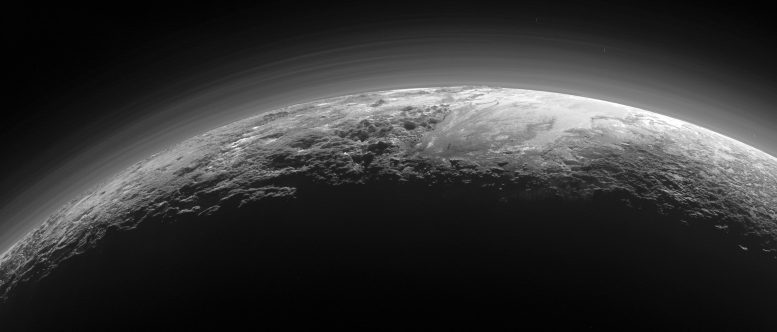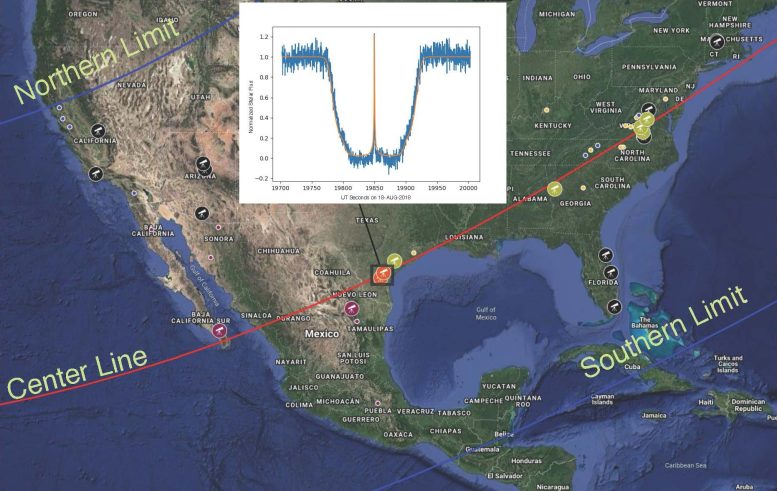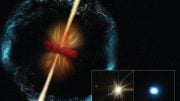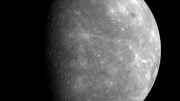
Just 15 minutes after its closest approach to Pluto on July 14, 2015, NASA’s New Horizons spacecraft looked back toward the sun and captured this near-sunset view of the rugged, icy mountains and flat ice plains extending to Pluto’s horizon. Credit: NASA/Johns Hopkins University Applied Physics Laboratory/Southwest Research Institute
When Pluto passed in front of a star on the night of August 15, 2018, a Southwest Research Institute-led team of astronomers had deployed telescopes at numerous sites in the U.S. and Mexico to observe Pluto’s atmosphere as it was briefly backlit by the well-placed star. Scientists used this occultation event to measure the overall abundance of Pluto’s tenuous atmosphere and found compelling evidence that it is beginning to disappear, refreezing back onto its surface as it moves farther away from the Sun.
The occultation took about two minutes, during which time the star faded from view as Pluto’s atmosphere and solid body passed in front of it. The rate at which the star disappeared and reappeared determined the density profile of Pluto’s atmosphere.

When Pluto passed in front of a star on the night of August 15, 2018, a SwRI-led team of astronomers measured the abundance of Pluto’s atmosphere, shown here in New Horizons 2015 flyby data, as it was briefly backlit by the well-placed star. These data indicate that the surface pressure on Pluto is decreasing and that its nitrogen atmosphere is condensing, forming ice on its surface as the object moves away from the Sun. Credit: NASA/JHU-APL/SwRI
“Scientists have used occultations to monitor changes in Pluto’s atmosphere since 1988,” said Dr. Eliot Young, a senior program manager in SwRI’s Space Science and Engineering Division. “The New Horizons mission obtained an excellent density profile from its 2015 flyby, consistent with Pluto’s bulk atmosphere doubling every decade, but our 2018 observations do not show that trend continuing from 2015.”
Several telescopes deployed near the middle of the shadow’s path observed a phenomenon called a “central flash,” caused by Pluto’s atmosphere refracting light into a region at the very center of the shadow. When measuring an occultation around an object with an atmosphere, the light dims as it passes through the atmosphere and then gradually returns. This produces a moderate slope on either end of the U-shaped light curve. In 2018, refraction by Pluto’s atmosphere created a central flash near the center of its shadow, turning it into a W-shaped curve.

During the August 15, 2018, Pluto occultation event, several telescopes deployed near the middle of the shadow’s path observed a phenomenon called a “central flash,” caused by Pluto’s atmosphere refracting light into a region at the very center of the shadow. This central flash indicates that the occultation data are very robust, bolstering SwRI’s findings that confirm that Pluto’s atmosphere is freezing out onto its surface as it moves farther away from the Sun. Credit: NASA/SwRI
“The central flash seen in 2018 was by far the strongest that anyone has ever seen in a Pluto occultation,” Young said. “The central flash gives us very accurate knowledge of Pluto’s shadow path on the Earth.”
Like Earth, Pluto’s atmosphere is predominantly nitrogen. Unlike Earth, Pluto’s atmosphere is supported by the vapor pressure of its surface ices, which means that small changes in surface ice temperatures would result in large changes in the bulk density of its atmosphere. Pluto takes 248 Earth years to complete one full orbit around the Sun, and its distance varies from its closest point, about 30 astronomical units from the Sun (1 AU is the distance from the Earth to the Sun), to 50 AU from the Sun.
For the past quarter century, Pluto has been receiving less and less sunlight as it moves farther away from the Sun, but, until 2018, its surface pressure and atmospheric density continued to increase. Scientists attributed this to a phenomenon known as thermal inertia.
“An analogy to this is the way the Sun heats up sand on a beach,” said SwRI Staff Scientist Dr. Leslie Young, who specializes in modeling the interaction between the surfaces and atmospheres of icy bodies in the outer solar system. “Sunlight is most intense at high noon, but the sand then continues soaking up the heat over course of the afternoon, so it is hottest in late afternoon. The continued persistence of Pluto’s atmosphere suggests that nitrogen ice reservoirs on Pluto’s surface were kept warm by stored heat under the surface. The new data suggests they are starting to cool.”
The largest known nitrogen reservoir is Sputnik Planitia, a bright glacier that makes up the western lobe of the heart-shaped Tombaugh Regio. The data will help atmospheric modelers improve their understanding of Pluto’s subsurface layers, particularly regarding compositions that are compatible with the observed limits on heat transfer.









Be the first to comment on "Scientists Use Occultation Event To Confirm Decrease in Pluto’s Atmospheric Density"